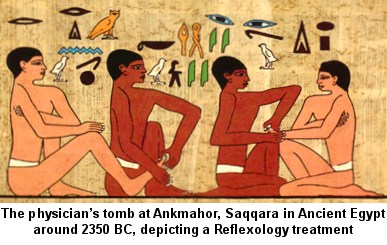
Reflexology :
Definition
Reflexology is a therapeutic method of relieving pain by stimulating predefined pressure points on the feet and hands. This controlled pressure alleviates the source of the discomfort. In the absence of any particular malady or abnormality, reflexology may be as effective for promoting good health and for preventing illness as it may be for relieving symptoms of stress, injury, and illness.
Reflexologists work from maps of predefined pressure points that are located on the hands and feet. These pressure points are reputed to connect directly through the nervous system and affect the bodily organs and glands. The reflexologist manipulates the pressure points according to specific techniques of reflexology therapy. By means of this touching therapy, any part of the body that is the source of pain, illness, or potential debility can be strengthened through the application of pressure at the respective foot or hand location.
Purpose
Reflexology promotes healing by stimulating the nerves in the body and encouraging the flow of blood. In the process, reflexology not only quells the sensation of pain, but relieves the source of the pain as well.
Origins
Reflexology is a healing art of ancient origin. Although its origins are not well documented, there are reliefs on the walls of a Sixth Dynasty Egyptian tomb (c. 2450 B.C.) that depict two seated men receiving massage on their hands and feet. From Egypt, the practice may have entered the Western world during the conquests of the Roman Empire. The concepts of reflexology have also been traced to pre-dynastic China (possibly as early as 3000 B.C.) and to ancient Indian medicine. The Inca civilization may have subscribed to the theories of reflexology and passed on the practice of this treatment to the Native Americans in the territories that eventually entered the United States.
In recent times, Sir Henry Head first investigated the concepts underlying reflexology in England in the 1890s. Therapists in Germany and Russia were researching similar notions at approximately the same time, although with a different focus. Less than two decades later, a physician named William H. Fitzgerald presented a similar concept that he called zone analgesia or zone therapy. Fitzgerald's zone analgesia was a method of relieving pain through the application of pressure to specific locations throughout the entire body. Fitzgerald divided the body into 10 vertical zones, five on each side, that extended from the head to the fingertips and toes, and from front toback. Every aspect of the human body appears in one of these 10 zones, and each zone has a reflex area on the hands and feet. Fitzgerald and his colleague, Dr. Edwin Bowers, demonstrated that by applying pressure on one area of the body, they could anesthetize or reduce pain in a corresponding part. In 1917, Fitzgerald and Bowers published Relieving Pain at Home, an explanation of zone therapy.
Later, in the 1930s, a physical therapist, Eunice D. Ingham, explored the direction of the therapy and made the startling discovery that pressure points on the human foot were situated in a mirror image of the corresponding organs of the body with which the respective pressure points were associated. Ingham documented her findings, which formed the basis of reflexology, in Stories the Feet Can Tell, published in 1938. Although Ingham's work in reflexology was inaccurately described as zone therapy by some, there are differences between the two therapies of pressure analgesia. Among the more marked differences, reflexology defines a precise correlation between pressure points and afflicted areas of the body. Furthermore, Ingham divided each foot and hand into 12 respective pressure zones, in contrast to the 10 vertical divisions that encompass the entire body in Fitzgerald's zone therapy.
In 1968 two siblings, Dwight Byers and Eusebia Messenger, established the National Institute of Reflexology. By the early 1970s the institute had grown and was renamed the International Institute of Reflexology.
In a typical reflexology treatment, the therapist and patient have a preliminary discussion prior to therapy, to enable the therapist to focus more accurately on the patient's specific complaints and to determine the appropriate pressure points for treatment.
A reflexology session involves pressure treatment that is most commonly administered in foot therapy sessions of approximately 40-45 minutes in duration. The foot therapy may be followed by a brief 15-minute hand therapy session. No artificial devices or special equipment are associated with this therapy. The human hand is the primary tool used in reflexology. The therapist applies controlled pressure with the thumb and forefinger, generally working toward the heel of the foot or the outer palm of the hand. Most reflexologists apply pressure with their thumbs bent; however, some also use simple implements, such as the eraser end of a pencil. Reflexology therapy is not massage, and it is not a substitute for medical treatment.
Reflexology is a complex system that identifies and addresses the mass of 7,000 nerve endings that are contained in the foot. Additional reflexology addresses the nerves that are located in the hand. This is a completely natural therapy that affords relief without the use of drugs.
Please do not stop any treatments your medical practitioner may have given complementary therapies are not designed as substitutes for medical care.